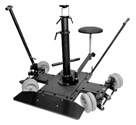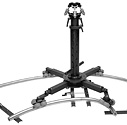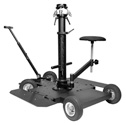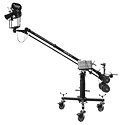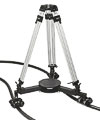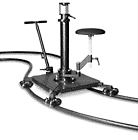Scott Losmandy, the owner of Porta-Jib, and the designer of all of the Porta-Jib products, opened a small machine shop in Hollywood, CA in 1981. After five years of producing for others, often making products that were not especially interesting to him personally, he began developing his own line of products to sell.
His first design challenge came about almost by accident, as a result of his taking up astronomy as a hobby, and joining a local astronomy club. After listening to members complain about the price and quality of the telescope mounts on the market, he off-handedly remarked one day, “Why, I could make a better mount than these,” to which the universal reply was, “Well, why don’t you?” And so Losmandy Astronomical Products was born and Scott Losmandy found his true calling as a design engineer. (Please visit our sister site at www.losmandy.com for a fuller understanding of this side of our business.)
However, since he happened to be located in Hollywood, he often did machining jobs for people in the camera manufacturing or rental business. In 1989, he realized that there was a need for a jib arm that would be portable, quickly assembled, and robust enough to support the weight of 35mm motion picture cameras. (Remember that in 1989, there were not many light weight cameras, and the industry’s idea of a small jib arm was a 150 lb. Elemack arm mounted on a 250 lb. dolly that could only provide a 3 foot lift.) And so Scott designed the original Porta-Jib, (or what we now call our Standard Porta-Jib to differentiate it from the subsequent Traveller and Explorer models). Amazingly, many of these twenty year old jibs are still in active service in rental houses around the world.
Mark Schweickart, sales manager for Porta-Jib since 1999, was at this time back in 1989, the camera rental department manager for Birns & Sawyer, which was just a few blocks away from Scott’s location in Hollywood. He was quick to see the value of the Porta-Jib and put several of them into his rental inventory. And Birns & Sawyer‘s sales department became its world-wide distributor. Scott, at that time, felt he had his hands full with the manufacturing end, and was happy to have someone else oversee the marketing.
Next for Scott came an interest in making a camera dolly. One day, seeing a Porta-Jib jib mounted on a doorway dolly in Mark’s rental department, they both agreed that it did not function very well in this configuration. In fact it looked downright dangerous. The dolly, especially when up on track, had a high center of gravity, and when this was combined with a flexing wooden platform and the difficulty of securely strapping the tripod to the dolly, Scott clearly saw the need for a new product to make his jib perform more effectively and safely. He went back to his shop and designed a better dolly--one he called, with all due humility, the Losmandy Dolly. Well why not, he had to call it something.
This was a dolly made entirely of steel for strength, had a low center gravity for maximum stability, an adjustable center column to replace the tripod, and an undercarriage with quick connect-disconnect linkage between the front and back wheels that allowed for an extremely tight turning radius. The dolly was then further accessorized with skateboard style track wheels on pivoting arms, and a double seat assembly so that it would function as an everyday dolly, not just as a jib support. And since it could do these exceptionally tight turns, it gave Scott the idea to make a specialized tight radius steel track, which was another first for the industry: track that could make a 90 degree turn on either a 2 foot or 4 foot radius. There had never been track like this before because there had never been a dolly that could make such tight turns. However, not everyone buying a Porta-Jib would be buying such a dolly. Therefore he also made a simple, yet extremely robust dolly that would accept the adjustable column. It was like having a bazooka column except it rolled on wheels for easy maneuvering of the jib. Thus began the sense of making things modular. The column could go on either the large Losmandy dolly, or on one of the small rolling bazooka dollies. This ability to interchange parts would later become a hallmark of the Losmandy line of products. And this particular device, the small rolling jib support would see a huge rebirth later when it evolved into the 3 and 4-Leg Losmandy Spider dollies.
Although both the Losmandy dolly and the tight radius track have since been discontinued, they provided the impetus for subsequent dolly incarnations: first, as the lighter Sierra dolly, which too has since been phased out in favor of the even lighter Spider dolly. And the floating wheel arms, originally designed for the steel dolly on the tight radius track, led to the floating arms of the Porta-Glide system, and, as strange as it may sound, eventually led to the idea of making a flexible track out of a rubber compound. Our FlexTrak never would have worked without having a dolly with floating arms to compensate for the variations in the track spacing that is inherent in rubber track. The same floating arms that made tight turns possible became the key to using rubber as a dolly track material. But this did not happen immediately.
Next in the ‘90s came a burst of activity in the industry centered around lighter cameras: the Sony Beta-Cams for news and documentary work, and (because of a huge improvement in films stock) the new Arri and Aaton 16mm cameras, also for documentaries, but especially for the new music video format. With the vast improvement in film-to-tape transfer that also was happening, one could now shoot for television in 16mm rather than in 35mm. People using these camera systems loved the Porta-Jib, but quickly made it known that something lighter was wanted. In response, Scott created the Porta-Jib Traveller, a jib that was light enough that it could be supported by the small 100mm style tripods that the customers already owned, and yet was strong enough to carry a Betacam or 16mm camera. The Traveller, with its clever fold-up design and light weight, became an instant success.
In the 90’s Scott was busy producing the Standard and Traveller Jibs, the Losmandy and Sierra dollies, the specialized tight radius track, and the Porta-Glide 90, named for its ability to due a 90 degree turn on a remarkable 2 foot radius. He even made a foray into making a cable operated remote head on a much larger jib arm. The products continued to sell, but, with the exception of the Traveller Jib, clearly they were staying on the heavy-side of “portable.”
And then a crushing blow came to Hollywood General Machining. Just as Scott was relying on Birns & Sawyer to market his jib and dolly products, he had a similar relationship with Celestron to market his telescope mounts. Then the news came that Celestron would no longer be carrying the Losmandy mount, but would instead be making their own, ahem, version. Sales plummeted on the telescope side of the business. But then, remarkably, calls started coming in from all over. First individuals, and then dealers still wanted the Losmandy mount. Scott began doing his own marketing of the telescope products, and soon business was back up. Having learned this lesson, he decided a similar change could happen on the Jib side of the business, and in 1999, Mark Schweickart left Birns & Sawyer to head up the new sales operation for Porta-Jib.
And as we all know, video cameras were steadily transitioning into ones providing higher and higher quality in smaller and less expensive packages. Seeing that we needed to address these changes, we decided to revamp our approach and put the “porta” back in Porta-Jib. The first major shift towards providing professional tools for the much lighter cameras was our introduction of the Spider Dolly and FlexTrak system in 2000, which won Porta-Jib a Best of NAB Award that year. This new system suddenly gave the camera owner the capability of carrying a rideable dolly and 40’ (12m) of dolly track in the back of a small vehicle. No longer would they be needing full-sized trucks to transport dolly equipment, or be wrangling clumsy 10 foot sections of traditional steel track or long sections of PVC pipe onto the tops of their cars. And better still, the Spider dolly’s modular design allowed one to have the ability to have a tripod dolly that could later be upgraded to a rideable dolly, or conversely, to have a rideable dolly that could be easily reconfigured into a smaller tripod dolly, which is especially useful for those jobs where you need to travel light or even work alone. Furthermore, the modular design also lets one further re-configure either dolly into a small trolley that can work with a mere 10 inches of separation between the tracks. The market responded very well to these designs and has kept us very busy.
Another important product came in 1997 when the Porta-Glide 90 was introduced. It was made for our tight radius steel track, but as we shifted our emphasis away from heavier systems, we discontinued this track; and, therefore, the elaborate pivoting wheel system on the Porta-glide 90 was no longer needed. Instead, in 2000, Scott turned his attention to making a better dolly sled, now simply called the Porta-Glide, by creating a truly breakthrough product -- one that would eliminate the flat-spot phenomenon inherent with all dolly sleds using skateboard style wheels. He solved this problem by making each of the dolly sled’s 16 wheels have a different diameter. Therefore, even though they do flatten like other wheels, as they turn, each flat spot is timed differently, so these flat spots are undetectable no matter how heavy the load or how long it sits. We are proud to say that the Porta-Glide with multi-dimensional wheels has become the dolly sled of choice for high-end dolly grips and camera operators.
Being the inventive person he is, Scott is always trying out new product ideas. Although we always thought that all of his ideas were a worthy addition to our line, not all of them caught on with the market, and now only exist here on our Legacy Page. Some of the discontinued products not previously mentioned include the Free-Styler and Free-Styler Jr, which were pan and tilt heads made specifically for front operated jibs that would give you more height capability than could be obtained with traditional fluid heads. The SkyPod, which was a tripod one could stand on for obtaining high angles without using of an additional ladder or platform. A couple of different slider configurations were abandoned in favor of our new Explorer system and Tracker system, but these also have since been discontinued. However, we are happy to say that most of the new products have caught on - our Lightweight Tripod for inexpensively supporting our Standard or Traveler Jib. The Low-Shot Kit for the 4-Leg spider Dolly. The Leveling Kit for using our FlexTrak in unlevel environments. The low-profile 3-Way Leveler for either the Standard or Traveller on our Light Weight Tripod, or on a Mitchell or 150mm tripod. The Spider dolly with Extended Legs for providing a secure rolling base for the Standard Jib. And the Balanced Monitor Bracket which provides a much more user-friendly monitoring experience when operating a front-operated jib.
And even though many cameras have gotten lighter, the professional end of the market still uses heavy cinema-style lenses, follow focus units, and matte boxes that require a more substantial jib; therefore, our Standard Jib remains our biggest seller. It future-proofs ones investment even if one is currently only using a light-weight camera system. It also is the only one of our jibs that can be extended to become a much larger jib.
Scott Losmandy seems to be getting more creative every year. So with any luck, not only will the employees of Port-Jib benefit from his imagination, but so too will the entire industry. We hope you too will become a loyal Porta-Jib fan if you are not already one. We pride ourselves on customer satisfaction, so give our products a try and let us know if there is anything we can do to make them better for you.
Mark Schweickart
Porta-Jib Sales Manager


